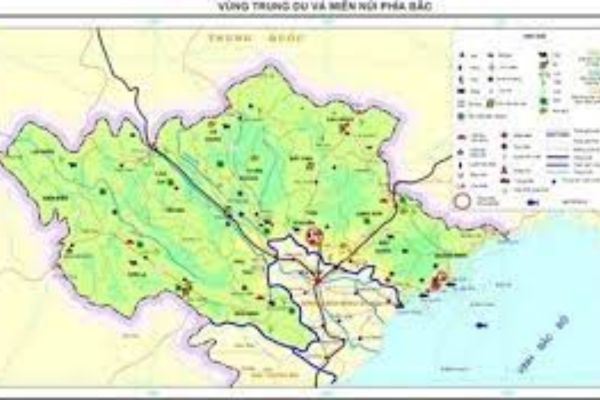What are the development perspectives in the Planning for Northern Midland and Mountainous Area of Vietnam for the period 2021-2030, with a vision to 2050?
What are the development perspectives in the Planning for Northern Midland and Mountainous Area of Vietnam for the period 2021-2030, with a vision to 2050?
In Section II of Decision 369/QD-TTg 2024, the development perspectives in the Planning for Northern Midland and Mountainous Area of Vietnam for the period 2021-2030, with a vision to 2050, are clearly stated as follows:
- The Northern Midland and Mountainous Areas must develop rapidly, sustainably, and comprehensively; gradually narrow the development level and living standards gap of local residents compared to other regions; ensure its especially important strategic position in economic-social development, ecological environment, national defense, security, and foreign affairs for the whole country.
Regional development must align with the national 10-year Socio-Economic Development Strategy for 2021-2030, the Sustainable Development Strategy, the National Green Growth Strategy, relevant national sectoral development strategies; ensure compliance, continuity, succession, and alignment with the National Master Plan and national sectoral plans.
- Economic development must be based on strengthening intra-regional, inter-regional, and international linkages; significantly improve the investment and business environment; intensify digital transformation and application of new technologies, suitable to the actual conditions of the region; progressively shift the growth model and restructure the regional economy towards a green and circular economy.
Strengthen the development of processing, manufacturing, and energy industries; high-value agriculture, modern technology application, organic production, special products; border economy, tourism, forest economy associated with forest protection and development.
- Preserve and promote the cultural identity and values of ethnic groups; develop the economy alongside ensuring social progress and equity. Preserve and promote the value of cultural and natural heritage, and revolutionary historical sites.
Enhance the quality of basic social services, particularly healthcare, education, and social protection; effectively implement policies for those with meritorious services and ethnic minorities.
- Organize development space according to sub-regions, driving regions, growth poles, and corridors linked with the Hanoi Capital Region and economic belts, including border belts connected with border gates.
Develop linkage chains in the region's driving areas in the Bắc Giang - Thái Nguyên - Phú Thọ corridor linked with the Capital Region, and linkage chains of urban centers associated with border urban areas.
Focus on the development of critical infrastructure, especially transportation infrastructure interconnecting localities in the region, with Hanoi Capital, the Red River Delta, and the North Central sub-region and internationally, to maximize the status and role as the Northern gateway of the country with China and ASEAN.
Develop a system of urban areas with synchronized, modern, smart infrastructure, having distinct identity, traditional ethnic values, in conjunction with nature conservation, environmental friendliness, climate change adaptation, and inter-regional connections with major cities in the Red River Delta.
- Strengthen the management and efficient, sustainable use of resources, particularly forest, mineral, land, and water resources, considering it an especially important task, central to regional development decisions.
Particularly emphasize environmental protection, ecological security, water security, nature conservation, and biodiversity, especially headwater forests and natural forests; proactively respond to natural disasters and climate change.
- Develop the economy and society associated with ensuring solid national defense and security; firmly protect the country's borders; effectively leverage the people's national defense and public security system; maintain political security and social order in the border areas.
Expand international cooperation and closely coordinate with neighboring countries on national defense and security, building peaceful, friendly, stable, and sustainable development borders.

Development perspectives in the Planning for Northern Midland and Mountainous Area of Vietnam for the period 2021-2030, with a vision to 2050 (Image from the Internet)
Is the average GRDP growth rate expected to reach about 7.5 - 8.0% annually in the Planning for Northern Midland and Mountainous Area of Vietnam until 2050?
The vision to 2050 in Section II of Decision 369/QD-TTg 2024 regarding the Planning for Northern Midland and Mountainous Area of Vietnam is as follows:
The Northern Midland and Mountainous Area will be a sustainable, comprehensive development region, a green development model of the country; some provinces will be in the high-income group, with advanced economies; forming several centers of modern processing and manufacturing industries; some high-efficiency concentrated agricultural production areas, service, and tourism sectors will be developed to a regional level; ethnic cultural identities will be preserved and promoted; the material and spiritual life of the people will be enhanced; national defense and security will be firmly ensured.
For the period 2031 - 2050, strive for an average GRDP growth rate of about 7.5 - 8.0% annually. By 2050, the average GRDP per capita at current prices will reach about 15,000 - 18,000 USD, the Human Development Index (HDI) will be above 0.75, the living standards of the people will be happy, and national defense and security will be firmly ensured.
It is forecasted to strive for an average GRDP growth rate of about 7.5 - 8.0% annually, and by 2050, when the Planning for Northern Midland and Mountainous Area of Vietnam is implemented, the average GRDP per capita at current prices will reach about 15,000 - 18,000 USD.
What is the scope of the Planning for Northern Midland and Mountainous Area of Vietnam?
In Section I of Decision 369/QD-TTg 2024, the scope, boundaries for the planning of the Northern Midland and Mountainous Area include the entire mainland of the 14 provinces, including:
Cao Bang, Dien Bien, Bac Giang, Bac Kan, Ha Giang, Hoa Binh, Lang Son, Lai Chau, Lao Cai, Phu Tho, Son La, Thai Nguyen, Tuyen Quang, Yen Bai.
To the north, it borders the provincial-level localities of Guangxi and Yunnan of China; to the west, it borders the Lao People's Democratic Republic; to the east and south, it borders the Red River Delta region and the North Central and Central Coastal region.
LawNet